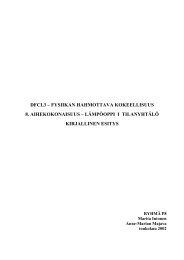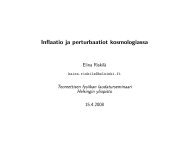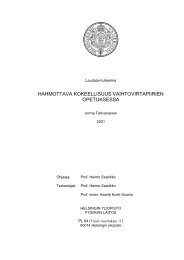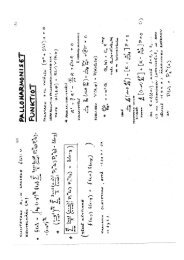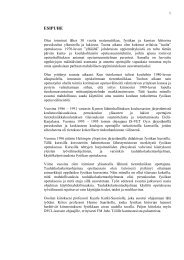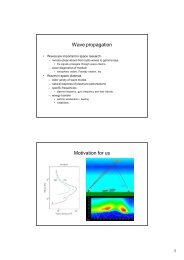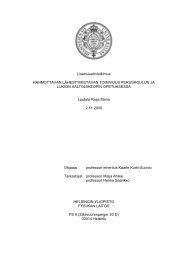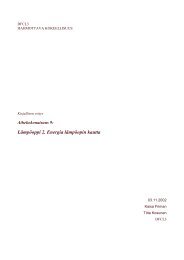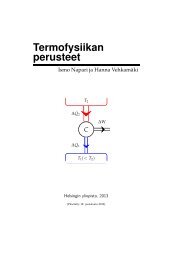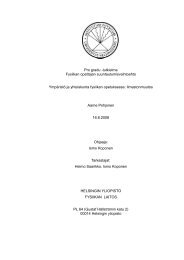Cosmological Perturbation Theory, 26.4.2011 version
Cosmological Perturbation Theory, 26.4.2011 version
Cosmological Perturbation Theory, 26.4.2011 version
Create successful ePaper yourself
Turn your PDF publications into a flip-book with our unique Google optimized e-Paper software.
20 THE REAL UNIVERSE 52interested in times much after neutrino decoupling. But the baryons and photons interact viaThomson scattering.Our continuity equations for perturbations are thus (for scalar perturbations in the conformal-Newtonian gauge)δ ′ c = ∇ 2 v c + 3Ψ ′ (20.4)v ′ cδ ′ bv ′ b= −Hv c + Φ= ∇ 2 v b + 3Ψ ′ + (collision term)= −Hv b + Φ + collision termδ ′ γ = 4 3 ∇2 v γ + 4Ψ ′ + (collision term)v ′ γ = 1 4 δ γ + 1 6 ∇2 Π γ + Φ + collision termδ ′ ν = 4 3 ∇2 v ν + 4Ψ ′v ′ ν = 1 4 δ ν + 1 6 ∇2 Π ν + Φ .We have put the collision terms for δ ′ b and δ′ γ in parenthesis, since it will turn out that they canbe neglected, and only momentum transfer between photons and baryons is important.In Fourier space these equations readδ ′ c = −kv c + 3Ψ ′ (20.5)v ′ cδ ′ bv ′ bδ ′ γ= −Hv c + kΦ= −kv b + 3Ψ ′ + (collision term)= −Hv b + kΦ + collision term= − 4 3 kv γ + 4Ψ ′ + (collision term)v ′ γ = 1 4 kδ γ − 1 6 kΠ γ + kΦ + collision termδ ′ ν = − 4 3 kv ν + 4Ψ ′v ′ ν = 1 4 kδ ν − 1 6 kΠ ν + kΦ .(Remember our Fourier convention for v and Π.)These equations are supplemented by 2 Einstein equations (there are 4 Einstein equationsfor perturbations, but since we are also using continuity equations, only two of them remainindependent). Thus we have 10 perturbation equations, but there are 12 perturbation quantitiesto solve. (If we think of the Einstein equations as the equations for Φ and Ψ, the “extra”quantities lacking an equation of their own are the anisotropic stresses Π γ and Π ν . In theperfect fluid approximation these vanish, and the number of quantities equals the number ofequations.) Also, we do not yet have the collision terms.Thus more work is needed. This will lead us to the Boltzmann equations which employ amore detailed description of the fluid components, in terms of distribution functions.In synchronous gauge one can simplify the cold dark matter equations, since cold dark matterfalls freely (in our approximation). Thus we can use cold dark matter particles as the freelyfalling observers that define the synchronous space coordinate, so thatv Z c = 0. (20.6)



